| Day 6 Xian, Chengdu ( B,L ) |
| After our whole day sightseeing tour in Xian, you are transferred to Chengdu by plane. Be met at Chengdu airport and transferred to the hotel. |
Great Mosque | The Great Mosque is one of the largest and best-kept Islamic mosques in China, which was originally built in 742 AD during the Chinese Tang Dynasty(618-907). It combined Islamic culture with Chinese traditional architecture seamlessly and became most featured and renowned mosques in China. | Ancient City Wall | It is the most well-preserved ancient military defensive systems in the world. It is composed of the moat, hanging bridges, battlements, watchtowers, tunnels and parapet. Today, the roadway is a promenade enjoyed by strolling tourist. Cycling on the wall with families is a great thing! | Shaanxi Provincial History Museum | It is one of the Top 3 national museums in China. This museum boasts 370,000 pieces relics range from prehistory when human just used simple stone tools to exquisite wares in the Qing Dynasty (1644–1911)., and enables you to see the vast changes of China in the past 5,000 years. |
|
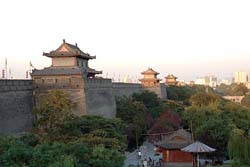 |
| [ Optional ] Muslim quarter: The Muslim Quarter features a mix of Chinese and Islamic cultures. It wins the reputation for the alley lined with market stall and the tasty snack food. Meanwhile, it is a good place to head for when looking for those hard-to-find souvenirs. |
|
| Day 7 Chengdu ( B,L ) |
| Visit the Panda Base in the early morning, when the lovely pandas are most active! Many other attractions in Chengdu are cultural relics through centuries. Learn their stories during your visit. |
Wenshu Monastery | Wenshu Monastery was originally built at this site in the north of the city during the Tang Dynasty. The building today however is a Qing Dynasty construction consisting of an impressive collection of buildings containing some intricate and beautiful art and architecture. | Du Fu's Thatched Cottage | Du Fu's Thatched Cottage (Dufu caotang) is the quaint former residence of one of China's most famous poets. The exhibits here include a brief account of Dufu's life and some of his original calligraphy and poems. | Chengdu Panda Base | In 1987, the Chengdu Research Base of Giant Panda Breeding (Research Base) was established on Futou Shan, an almost barren hill, where the soil was poor and not suitable for farming. This first phase of the project only covered an area of 5.5 hectares. Giant pandas and scientists from the Chengdu Zo…… |
|
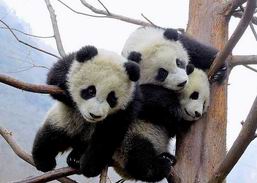 |
| [ Optional ] Visit a teahouse at night: The life in tea house is one of the most important entertainment for locals. Shufengyayun once was a teahouse, where permance of Sichuan opera, acrobatic show can be seen there. In recent years, Shufengyayun gathers the distinguished actors in Sichuan Province once again and holds Sichuan Opera Unique Skills Performance at night. |
|
| Day 8 Chengdu ( B,L ) |
| Today, we will be driven about 2 hours to Leshan and take a cruise to visit the Giant Buddha carved out of the cliffs at the confluence of the Dadu, Minjiang and Qingyi Rivers. After, you will be driven to Mount Emei to visit Baoguo Temple. You will stay overnight at the foot of Mount Emei. |
The Baoguo Temple | The Baoguo Temple (Nation-dedicating Temple) is the first temple one meets along the mountain way and stresses love and patriotism. The temple has the typical structure of Chinese ancient garden covers an area of more than 10 acres. Every yard of the temple is quite different from another by its un…… | Leshan Giant Buddha | Leshan Giant Buddha is one of the most magnificent tourist attractions in Sichuan Province . It's located on the Westside of Xiluan Peak ( Phoenix Perched Peak ) of Mount Lingyun , just east of Leshan City . |
|
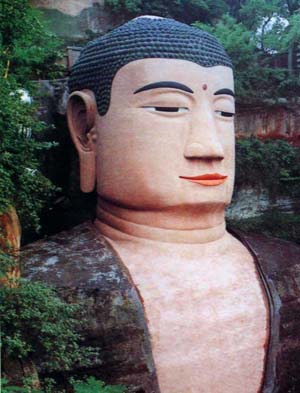 |
| [ Optional ] Sichuan Hotpot: Sichuan Hotpot has its history of at least 1700 years, first eaten by poor boatmen of the Yangtze River. People use some chicken to basic stock, then add many types of mushrooms, vegetables and hot peppers, with many flavorings and seasonings. |
|
| Day 9 Chengdu ( B,L ) |
| We will visit Mt. E'mei. We will drive to Leidongping first, then take the cable car up to visit the Wannian Temple. Drive back to Chengdu in the afternoon. Leisure on your own at the rest of the day. |
Wannian Temple | The Wannian Temple of 10000 Years is the oldest surviving Emei Temple (reconstructed in the 9 th century). Its dedicated to the man on the white elephant, the Bodhisattva Puxian, who is the protector of the mountain. | Mount E'mei | MT. Emei is about 160 kilometers southwest of Chengdu, Sichuan Province. It extends for over a hundred kilometers and resembles the fine eyebrow of an ancient Chinese beauty from afar. |
|
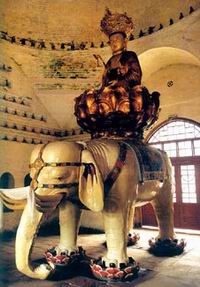 |
| [ Optional ] Wide and Narrow Alleys: Wide and Narrow Alleys is a region of three major historical and cultural protected areas, it is known as a "Millennium small Old Chengdu". it is aslo a leisure center for people to relax having some quality time with friends in the mixed old and modern atmosphere. So inside those nicely restored old houses, there are restaurants, pubs, tea houses, coffee shops and stores etc. |
|
| Day 10 Chengdu, Lhasa ( B ) |
| Transferred to Chengdu airport for the flight to Lhasa. Upon arrival at Gonggar airport, you will be met by our local guide and transferred to the hotel (2-hour drive). On the way you will view the Giant Stone Buddha carved into the side of a mountain. After checking into the hotel, the rest of the afternoon is yours to relax and let your body adjust to Tibet's high altitudes. |
Lhasa | Lhasa has an elevation of 3650 meters and sits at the center of the Tibet Plateau. It has a history of more than 1300 years. It towers as a huge magnet attracting those who want to explore its culture. Entry into Lhasa allows each traveler the chance to glimpse into Tibet. |
|
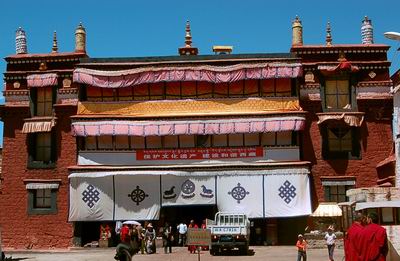 |
| [ Optional ] Tibetan Opera Performance: The Tibetan people are good at singing and dancing. Tibetan opera is called "Ajilamu" in Tibetan which means "sister fairy maiden". It is a kind of public square opera, which has play, vocal music, separate roles, accompanying band and special masks and clothes, and its main form is song and dance. |
|